
THIS WEEK, ORA-ORA SPEAKS WITH MULTI-MEDIA ARTIST HUNG KEUNG ABOUT A NUMBER OF HIS ARTWORKS, REFLECTING ON HIS ARTISTIC JOURNEY AND INTENTIONS.
Dr. Henrietta Tsui-Leung as Henri
Hung Keung as Keung
Keung: There are two very important factors that made an impact on me while I was growing up. Firstly, I had great mentors in my life who inspired me. Secondly, while I was acquiring knowledge, I was taught to find the source of knowledge. I was taught to try my best to find it and not be easily satisfied by only having superficial understanding of a piece of information. These two issues affected me a lot.
I met my first mentor when I was around 12 to 13 years old. He influenced me a lot. I have met similar influential and respectable mentors while I was growing up. They all have the same learning attitudes, they are serious about pursuing knowledge across disciplines where others would regard as abstract or conceptual back in the days. Their hard working attitudes became deeply rooted within me and I strove to become more like them and followed in their footsteps.
Henri: What you said about “finding the source of knowledge” is basically you being an inquisitive learner and getting to the heart of things. Don’t just blindly believe in the information laid out in books or said to you by other people. If you are genuinely interested in one subject matter, you have to dig deep to find the source. I think this is actually what makes contemporary art so interesting. A lot of times, we might be able to obtain information from those around us regarding both local and international social issues. However, artists like us have different ways of perception and we will be able to derive another meaning from the information given to us. We are determined in a way that we won’t easily settle with face value and will dig deeper to find the true meaning.
Keung: I agree.
Henri: What does “finding the source of knowledge” have anything to do with you travelling to Europe?
Keung: The story will have to begin when I was studying at the Chinese University of Hong Kong. I need to thank two very special people amongst others. The first person I need to thank is Ho Siu-Kee, he was my teacher when I started learning drawing at 13.
Henri: Oh wow you are lucky!
Keung: He was also very young then. I was very passionate about drawing back then, and one day I was strolling along the streets trying to find a centre for drawing where I could be taught properly to draw. I saw there was a drawing lesson advertisement there and immediately signed up without any hesitation. The teacher was Ho Siu-Kee.
The second person I need to thank is Chan Yuk-keung. When I was in Year 2 or 3 at university and was about to graduate, I became fascinated with moving images and wanted to make videos and films. I was interested in anything related to moving images. I started talking to Chan Yuk-keung about my passions and ideals. At the same time, a German experimental film troop came to Hong Kong for an exhibition at the Arts Centre. I realised that is my world and would love to step inside that world. Chan Yuk-keung told me, “Hong Kong will not be able to help you.” He was very direct, which I feel is what teachers should be. He told Hong Kong cannot give you what you want.
Henri: Very direct.
Keung: I was of course very hurt. But I was very appreciative of how he showed me the reality of things. He said to me I would probably have to consider developing my skills elsewhere from Hong Kong. That should be around 1993 or 1994. After listening to his words, I contemplated leaving Hong Kong. During that year, Central Saint Martins opened a new postgraduate course called “Film and Video.” It was perfect match for me, and I was very lucky. I immediately enrolled in the course.
Henri: Did you family support you financially? Or did you support yourself?
Keung: I am from a grassroots family so my family did not really have money to support me studying overseas. I worked for one year and earned around 8000–9000 HKD every month, and $30,000 in total. That was all I could do.
Henri: So you decided to pursue your dreams with the money you had.
Keung: At that time, I was allowed to pay $20,000 deposit of registration fee. Once I got there, I would have to pay the rest of my school fees. I was very mischievous and told the school I had no money when I got there. I asked whether I could pay by instalments and they told me there was no such policy and that I would have to pay in full. I really had no money so I resorted to drawing on the streets and working part-time at restaurants. I still did not have enough money. Some friends and university classmates helped me by lending me some money. They each lent me around $5000 or $8000. I still did not have enough money.
I coincidentally saw Chan Yuk-keung while I was in Venice. I was still very poor then, but I still could not miss the opportunity to go to Venice! He knew of my situation, and told me not to be hesitant to ask for his help and assistance. I was really poor — I could only afford to eat 4 chicken wings and 1 egg every week. I drew life sketches on the streets for 5 pounds a drawing. 5 pounds is around $50 to 60 a day. Sometimes I had 5 to 10 cases per day, sometimes I had zero. I would sit down in Trafalgar Square or Charing Cross to draw for 10 hours from morning to midnight. There were usually many people late at night because they liked to stroll on the streets when they missed their trains and would rather wait for the night buses. A lot of people would walk around at 11pm when they missed their trains. Most days I got zero or 1 case even though I sat there for the whole day. I told myself, “I had overcome so many obstacles to come to London, friends and family lent me money — I did not come here to sit for hours, I came here to learn.” I sent a message to Chan Yuk-keung to ask for help.
The school was actually good to me, they disregarded the policy for me and allowed me to pay by instalments. But they also said they won’t show me my grades if I was not able to pay my school fees. They won’t disclose my subject grades. I thought that was quite fair and reasonable. After I messaged Chan Yuk-keung and told hiim of my situation, I was awoken by a phone call at midnight while I was sleeping. There was time difference between Hong Kong and London. The phone rang and I tiredly asked, “Hello, who is it?” On the other side, Chan Yuk-keung said, “Keung, can you hear me? I am Chan Yuk-keung!” I asked, “What is it?” He said, “Do you have a passbook? Did you receive the money I gave you?” I was very touched and asked, “What? What passbook?” He told me, “I wired you some money, see you if received it!” Some other Chinese University classmates also phoned me, including Ho Yuen-leung, Leung Chung-kei and Au Ka-wai, they all wired me money.
Henri: Thank you for your sharing. I got really touched too. That was the beginning of crowd funding.
Keung: Exactly. They supported my education. When I got back to Hong Kong after receiving a postgraduate degree in Moving Image, I worked at Radio Television Hong Kong. That was the time when digital interactive media started to become popular and there were different interactive programmings. I was extremely happy and amazed. Before I left London, I wrote a proposal on the relationship between human beings and moving images and made a CD-rom about it. I worked on the interactive project for 3 years, starting from 1998 and published it in 2001. I was very happy about the results and made around 1000 copies of the CD. People thought it was interesting, but they didn’t completely understand. I designed the CD to not show the mouse cursor while you play the game. I changed the mouse cursor to a flame, I wanted to show that the mouse cursor is just like a flame in a cave that would lead the player to a certain direction. There is symbolic meaning to it, that the mouse is just like a flame that would lead us to an invisible or mysterious space. I was very dejected by the reaction. I worked it on the project for 3 years but no one understood me. I did not know how to communicate and explain the deeper meaning. It was like I was mute.
Henri: It was like there’s a gap between you and the audience.
Keung: Yes, and this is something I have to improve upon. I went to Germany. Long story short, I went to the ZKM Center for Art and Media. I need to thank the school because I had to embark upon a 14 month journey to Germany. I discussed with the school whether I should end the contract before going to Germany. The senior management was very supportive. John Fraser, the department head at the time, told me there’s no need for me to resign nor to end my contract, I could leave whenever I wanted just with the suspension of pay. He said it’s not complicated and that I should go ahead. I felt relieved and immediately packed my bags to leave. The world is very different in Germany. Jeffrey Shaw took me in.
Henri: He’s now in Hong Kong!
Keung: Yes. At that time, he was director of the research program at the ZKM Center for Art and Media. I am very grateful he took me in. During that year, I met the professor of my future doctorate course in Switzerland. Every step of the way, I was able to meet these important and inspiring people.
Henri: Step by step, you walked the distance and got to where you are now.
Keung: I am very touched and grateful.
Henri: Do you have any artworks you would like to share with us and discuss?
Keung: I prepared some. One of the works is called Dao Give Birth To One (2013). I like this piece of work very much. You can see the concept of Chinese scroll art.

You have to view it from left to right. It starts with a few numbers and Chinese characters and towards the end, you can see ten thousands. The artwork takes the form of a Chinese scroll. There are 12 groups of pieces. The length and content of each group is different. But each of them is related to the theme of human beings’ body parts and organs. Under the scroll are stools of various height and shapes. Some of them I borrowed from other people, some of them I collected personally, some of them I exchanged with other people. They are all placed here.
This is one of my favourite pieces. It is teemed with ideas and emotions I have gained and felt while I was growing up. It contains knowledge I gleaned from my family and my culture. I also wanted to suggest a further step: that new media within the Chinese culture and society can both co-exist with and divulge from Western culture. There is no need to follow in the West’s footsteps, there’s no competition. Both can be parallel and walk different paths. I suggested several rhetorical questions within the piece. It is an interesting milestone for me personally.
I spent more than two years studying design in Poly University before I did postgraduate design at Chinese University. It was a very interesting time. There were many teachers at that time. For Example Rosanna Li, Choi Yan-chi (who already left Poly University) and George (he did many performances with musical band, The Box) were all my teachers. They were very interesting and taught us many conceptual artistic elements like how to combine these artistic elements with visual art. I learnt a lot about spatial proportions, balancing, design languages, which I now incorporated into my work. I would subconsciously apply these design principles into my creative work. You can probably spot the balance, spatial awareness, proportions, dramatic forms and visual dynamics in my works. I always think about the design language before considering the creative format and direction of my work.
Keung: The first one I’d like to show you is Circular Reflection. It is a series of work that is an extension of my research project on human beings’ access to three different realities. The artwork is built upon the concept of parallel realities. It involves light and digital images. The second piece of artwork involving light and spatial relationship between objects is taken place in the Man Mo Temple. It was an interesting project and Hong Kong is an interesting place. When I first went to discuss the project with staff working at the Man Mo Temple, I was trepidatious. I did not know what I was going to wear for the meeting, it was such a traditional and classical architecture, was I supposed to wear a suit and tie? Once I got there, they told me I could do whatever I want and asked me what I could give them. They were so supportive and I was very happy. When the exhibition was finished, I talked with the staff again and they asked me whether I have any future projects where I could collaborate with them so I could further elaborate on my artistic messages. This is very encouraging for every artistic creator. Setting the exhibition at such a space can expand the possibilities of an artwork and it’s not limited by physical constraints. This makes me optimistic.
Henri: Yes.
Keung: The concept of Circular Reflection is actually quite simple. It is a series of three works, including The Grand Spectacle, The Dual Perspective and The Abstract Cosmos. All three works explore the possibilities of digital media in helping us understand human beings’ relationships with different realities. It gets more complicated. The Grand Spectacle is interesting. When you visit the installation, you are not able to see yourself clearly. The mirror is blurry. The exhibition is set in a busy part of Tsim Sha Tsui. I would like to dedicate this installation to the viewers and to remind them to look at themselves for 5 minutes. If the viewers are willing to just stand and look at themselves for 5 minutes, they will no longer see a blurry self but will be able to view a clear image of themselves.
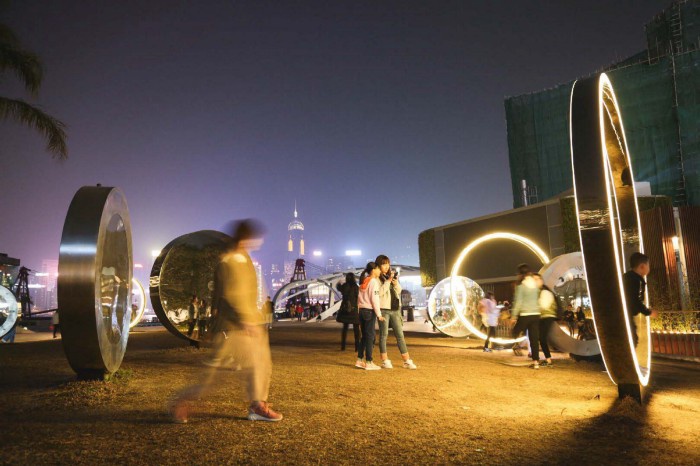
Henri: Wow.
Keung: They can only see a ‘clear self’ if they are active and willing to do that. This is an interactive work which I personally quite like. At first, you can see a blurry image of yourself. But if you are brave and willing to manage your body in an unmoving pose for at least 3 minutes, you will see that your reflection will become increasingly clear.
Another part is The Dual Perspective, I filmed a series of the view at Victoria Harbour. I hoped the audience could participate in this virtual reality and view Hong Kong through different perspectives. I collaborated with different architects and designed virtual reality helmets.
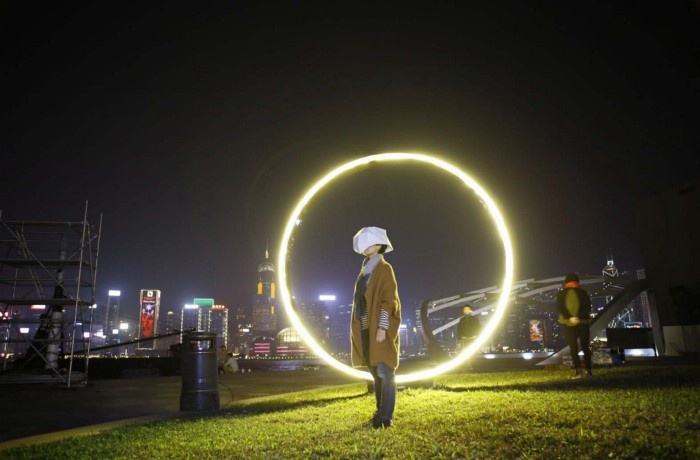
There is a story embedded within the virtual reality videos. There are characters of secondary school students, tourists, and unemployed youths. A lot of life’s trivialities are input within the videos. Some wise old ladies are also featured within the artwork. This is The Dual Perspective, please have a look.
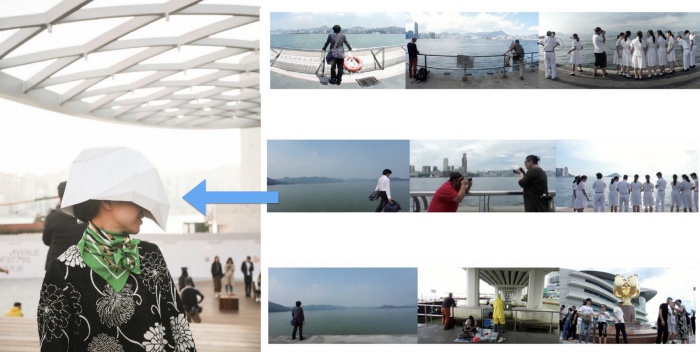
Image: The Dual Perspective (2018); Virtual reality helmet and video (Image courtesy of Ora-Ora and the artist)
You can see that with the virtual reality, it does not only overlook Victoria Harbour, there’s also a drone used to capture us from the outside. There are inside-out and also outside-in perspectives.
Henri: This is a series of work that involved lots of research. Which part of your work do you feel most satisfied about? Are there any challenges? You just mentioned there was a gap between your CD-rom project and your audience, where there were a lot of misunderstandings and confusion. From what I could see in your video, it seems like the audience was quite immersed within this interactive art. What are your reflections on that?
Keung: I was very happy when I was done with this project because it meant I could finally relax and take a break!
Henri: This is a very large-scale project.
Keung: It involves a lot of participation from my friends. This is a good question. I had never compared this interactive project with my earlier CD-rom work. I found a good channel and platform to express my thoughts. As an artist, I feel this is very necessary. Secondly, I have trained myself to use language to dissect and explain the minute details of my work. This is what I have trained myself to do these few years. Compared to previous works, I would say this project is a bit self-indulgent. I had to apply for financial grant, to design and cut my installations, to explain my work, to make phone calls, to transport and sell the works to bookshops. The whole project is a self-indulgent work. I never tried to understand the audience for my CD-rom project. Perhaps they really needed explanations for my work, but at that time, I did not have the training to approach the viewer and audience. I was just able to physically present my work to them. Now that you asked that question, I have been able to do some self-reflection. Years ago, I was only able to “do.” Now, I not only can “do,” but can also consider the feelings and needs of the audience and to really interact with them.
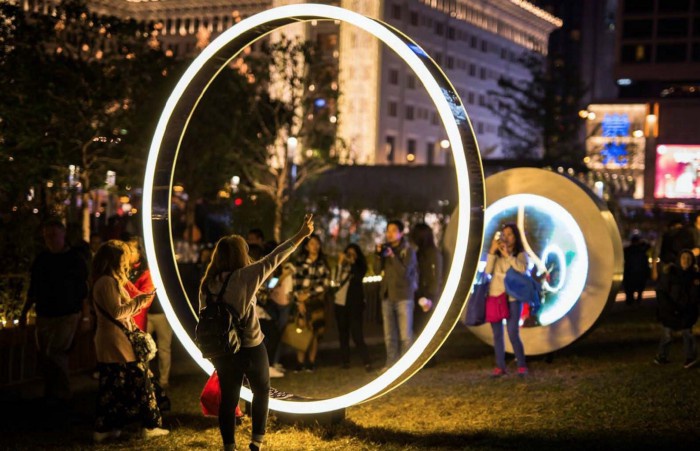
Henri: I would like you to introduce us to your Man Mo Temple project.
Keung: Sure. The Man Mo Temple project is an interesting one. As I said, before I went to Man Mo Temple I did extensive background research and had official support from them. There are two parts in this project. In the first part, I wanted to display the concepts of dawn, dusk and solar eclipse.
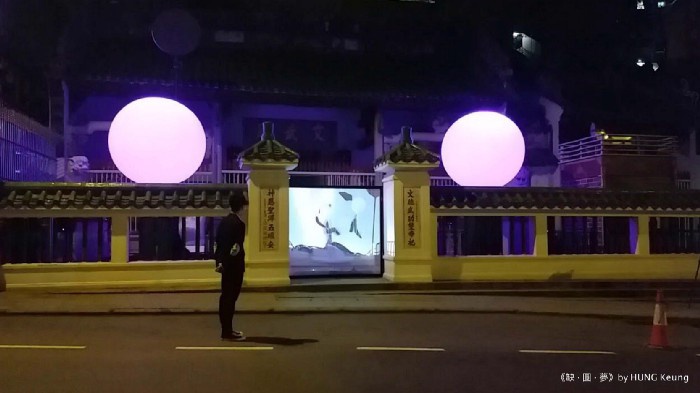
Image: Hung Keung’s Artwork — The Void. The Fulfilment. The Dream (2017) at the Man Mo Temple (Image courtesy of Ora-Ora and the artist)
I collaborated with a team and reimagined the solar eclipse using digital media and handmade tools. For the second part of the show, I’d like to bring the moon onto earth. The cycle of dawn and dusk is related to the moon, earth and sun. We made two balls that represented the two unreachable physical objects that we could now see in Man Mo Temple. We did that because we thought it would be interesting. We also constructed a door, which has a symbolic meaning. Every time we enter and exit the Temple, we pass through the door which symbolises the connecting of two universes. We constructed a fake door; a performance is featured on it. A person will guide us to enjoy the virtual world. This is an interesting scene. This is the making-of of the Man Mo Temple project which introduces the concept.
Henri: The idea of the project is very imaginative, but I know the research you had undertaken for the project must have been extensive and meticulous.
Keung: Thanks for asking this question. I would have mentioned it, but I thought it would be quite boring. I would like to share a book with you by Wu Hong, a professor at Chicago University who specialises in traditional and modern Chinese art. I love conducting literary research. I have done a lot of work on parallel spaces. I noticed that Wu Hong had done a lot of research on Chinese marble statues of handmaidens carved on doors. This is a door to a cemetery. The handmaiden has a symbolic meaning and she serves the purpose of bringing us to another dimension. I thought the concept was very interesting and decided to bring it to my Man Mo Temple Project.

We did five scenes, just like a stage play. The first one is Night Smoke. The Man Mo Temple would suddenly explode on the right hand side with a bang and smoke would come out. Neighbours were scared as they did not know what was happening and they reported to the police. Police cars and fire engines all came to the scene. But I told them that it was merely a performance. The smoke could have been on a larger scale, but after receiving complaints, we reduced the intensity of the smoke in consideration of the residents’ needs.
Henri: Of course. The residents have been accustomed to having artists in the area throughout the years.

Image: Different lighting and stages of the eclipse during the performance at Man Mo Temple (Image courtesy of Ora-Ora and the artist)
Keung: You can see that the concepts of the solar eclipse and lunar eclipse are presented here. It shows the cycle of solar eclipse, and when accompanied with the background music, has a romantic atmosphere. Slowly you can see different lighting surrounding the Man Mo Temple. It shows the interaction between Man and Mo. Towards the middle, you can listen to some mobile phone ringtones. These mobile phone ringtones imitate the signals of worship. It is some sort of coding.
Slowly, you can hear dialogue and see animation of the interaction between Man and Mo. You can see animations of the green dragon crescent blade and the Wrenching pen. Next, I invited the moon, the sun and the earth to join us. They slowly rise up. There is animation on the gates. There is a laser performance. Different lighting display different scenes. Finally, you can see lighting effects. I like this part. There are a lot of things I wanted to do but couldn’t do because we are constrained by safety guidelines. It is interesting to share this with you. I tried my best. Next you can see a woman, she is sleeping and dreaming.
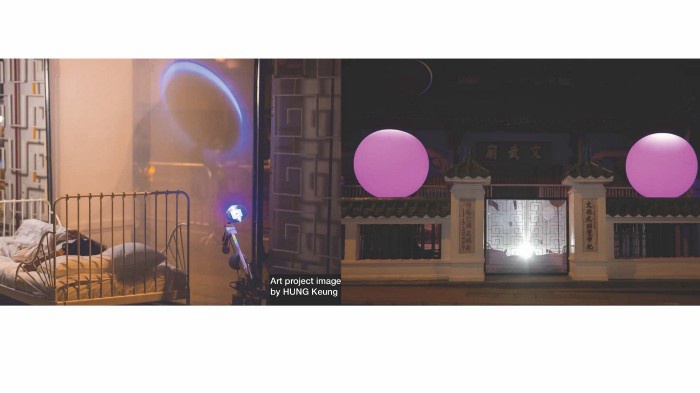
Henri: There are passersby walking past the temple.
Keung: Yes they are walking past the gate. Once we saw a hearse carrying three coffins drive by as well. It was a funny scene. I was very happy. It was interesting. I incorporated Professor Wu Hong’s concept of the handmaiden in here. There are spirits circling the gates while the handmaiden is sleeping. The spirits are a connection between our physical world and other dimensions. There are different sound effects and images. When you think the performance has concluded, we switched on a light. I like this part. I collaborated with an artist called Roy and crafted this “transformation.”
Henri: What is it?
Keung: It is a light that imitates the lunar eclipse and solar eclipse. You can observe that light is changing slowly. This is an installation that serves as a conclusion to the performance. When the cycle of the lunar eclipse and solar eclipse ends, the woman will wake up and glance at the audience, as if she is looking us our dimension through her spiritual dimension. The show will start again after this. The part where the woman is sleeping is the intermission. Our message is that, while the show has an intermission, life does not. The intermission is when the girl is sleeping. After she has experienced both the lunar eclipse and the solar eclipse, she would wake up and the show will loop again for the whole night.
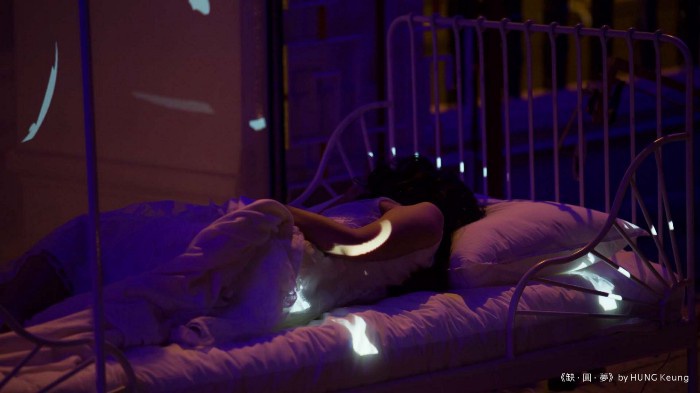
Henri: How do you balance artistic creation and research?
Keung: Good question. I can take this opportunity to rant. This is something I’m still struggling about and learning to balance. I’m now teaching in a university, and undoubtedly, I would want to share everything I’ve learnt with my students. At the same time, I have other responsibilities such as carrying out research and producing some results. As you asked, will doing research help with my artistic creations? I think yes, but not in a parallel way. I am currently undertaking two different kinds of research. The first is artistic research regarding the unforeseeable future. In university, it is hard to evaluate research on abstract concepts such as the unforeseeable future. This is why I’m also undertaking another research which is comparatively more concrete, theoretical and academic. It can be explained easier by language on paper. This needs a more dow-to-earth topic. University research has to be more concrete and less abstract, it usually deals with issues involving the community, such as children with disability, elderly, exhibition spaces. These research topics can contribute to the betterment of the society and different communities. This is the type of research I’m currently doing at university. On the other hand, I am also researching visual and technological concepts to try and suggest different approaches in exploring the unforeseeable future. This is also something I’m doing currently. Of course, university is a platform that can give me a great degree of flexibility where I can balance artistic creation and research.
Keung: I have a work called Control Freak displayed at the Asia Society. This is like dessert. You may know an artist who is known for writing about hearts and love. He has a work that is related to the theme of love. In a lot of public spaces in other countries, you can see large installations of the word “LOVE”. This artist has a retrospective in Asia Society, and I’m one of the Hong Kong artists invited to participate in the exhibition. There are also other South East Asian artists participating. I was honoured to be invited.
I did some research on the theme. I learnt that one of the artist’s works feature the simplified Chinese character for “love”. I think it was written very beautifully. I wanted to add the character “heart”(心) in his work. There is no “heart”(心) in the simplified Chinese character of “love”(爱), but there is one in the traditional Chinese version (愛). My work is featured before the artist’s. The viewer can see the simplified Chinese “love” and also my work underneath it. So what does my artwork look like? It is an interactive piece. It is called Control Freak. Let me introduce my work. My work aims to invite the audience to write the word “love” together. This is how it looks like live.
You need to write with a Chinese brush in a situation where control and loss of control exists at the same time. What’s the situation like? The process is interesting. I collaborated with a programmer who used a technological device to write out the character “heart.” The machine is like this.
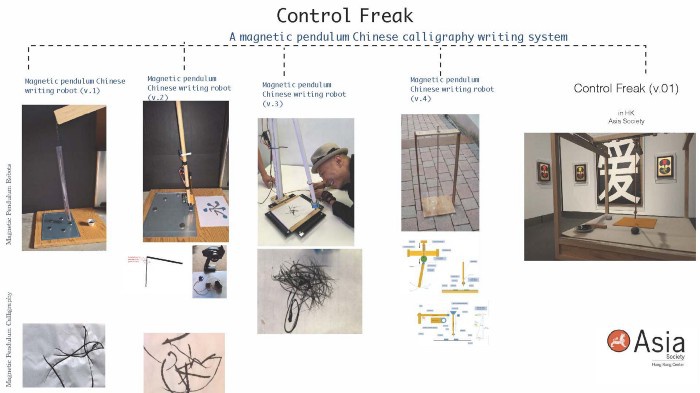
Image: Process of building the Chinese calligraphy writing system for Hung Keung’s artwork — Control Freak (Image courtesy of Ora-Ora and the artist)
It is installed inside the table. It traces the strokes of the character using a magnet. The route of the magnet is the strokes of the character. A piece of rice paper is laid on top of the software. In the exhibition, you use ink to write the word. The interesting part is that the brush is attached to a magnet. You can’t hold onto the brush, you have to use the lever next to it. Underneath the rice paper, the machine will guide you in writing the word. The audience can experience a unique feeling where they are both in control and not in control of the situation through writing the character.
Henri: So the audience thinks that he is controlling the brush when in fact there is a magnet underneath the paper that is guiding his every actions.
Keung: I collected around 200 hearts a month during the exhibition. You can see that everyone’s “hearts” are different, but the track is the same.
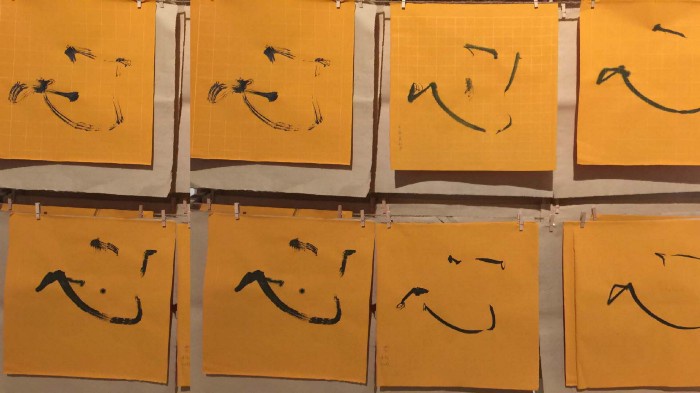
Henri: Because of the invisible “hand” that is guiding them.
Keung: I put all the hearts paintings together to make an animation. It looks like this.
Animation of different “hearts” (Courtesy of Ora-Ora and the artist)
The message is that everyone has the heart to understand the meaning of love. Everyone experiences love in a different way. Everyone has their own feelings and emotions and experience to interpret love. Everyone’s experience is different, even though we all know how to write it the same way. We all know how to write the character, the strokes for the Chinese characters “love” and “heart” have stayed the same for a thousand years. But just because the character has stayed the same does not mean that everyone’s experiences are the same. I think this project is quite primitive and not totally successful, there are a lot of things that need improving. For example, the brush has been broken three times. Our mechanical tools are very fragile as they are made from wood. Some audience enthusiastically twisted the lever and everything broke as a result. Therefore, there’s room for improvement. Nevertheless, I still wanted to share with you my concept. Especially now when everyone uses their phone to type messages, we all know to how to type characters using correct strokes. However we all seem to have disconnected from the meaning behind the words we type.
Henri: I understand more from you that you are a director, a researcher and a positive influence.
ABOUT ORA-ORA LIVE
Each week, Ora-Ora will speak with various members of the art community — including artists, curators, academics and other professionals working in the cultural sector — to address topics of interest related but not limited to Hong Kong’s art and cultural scene. The series aims to be an outlet for creativity and a means to connect with peers who share similar interests. The episodes will also available live on Ora-Ora’s Instagram (@galerieoraora), Facebook (Galerie Ora-Ora) and later on Ora-Ora’s YouTube channel.
